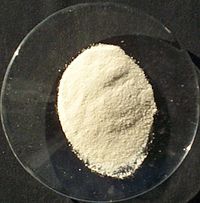
Photo from wikipedia
Abstract In this work, a series of MnOx/TiO 2 -Al 2 O 3 oxides synthesized via sol–gel method were evaluated for catalytic oxidation of HCN under micro-oxygen and low temperature… Click to show full abstract
Abstract In this work, a series of MnOx/TiO 2 -Al 2 O 3 oxides synthesized via sol–gel method were evaluated for catalytic oxidation of HCN under micro-oxygen and low temperature conditions. The reaction temperature, oxygen concentration, Mn content, relative humidity and calcination temperature of catalysts were the five crucial factors that were determined during the study. 15 wt% of MnOx/TiO 2 -Al 2 O 3 performed excellently on HCN catalytic oxidation, and nearly 100% HCN conversion and 70% N 2 yield were obtained at 200 °C. The comparison of H 2 -TPR, BET, FTIR and XPS results from fresh and used catalysts revealed that both oxygen types, namely chemisorbed and lattice oxygen, as well as adsorbed water molecules and several chemical states of Mn, including Mn 4+ , Mn 3+ and Mn 2+ , were the main active species on the catalyst’s surface. It was found that the occurrence of hydrolysis of HCN was accompanied by the HCN catalytic oxidation process. In HCN catalytic oxidation process, the catalytic hydrolysis of HCN that occurred could be ascribed to two sources of adsorbed water molecules: (i) the catalyst itself, which contained adsorbed water molecules; (ii) the re-adsorption of water molecules that produced by HCN oxidation reaction. The water vapor introduced had obvious inhibition to HCN conversion and N 2 yield may be due to the competitive adsorption between water molecules and HCN. Based on XPS, FTIR results and early studies, HCN pre-reacted with water molecules from the catalyst’s surface to produce NH 3 and CO. Both of these products were readily further oxidized to produce N 2 , H 2 O and CO 2 under low temperatures, but they were oxidized to NO instead at high temperatures. Meanwhile, only a small amount of N 2 O as an undesirable by-product produced in this reaction process.
Journal Title: Chemical Engineering Journal
Year Published: 2018
Link to full text (if available)
Share on Social Media: Sign Up to like & get
recommendations!